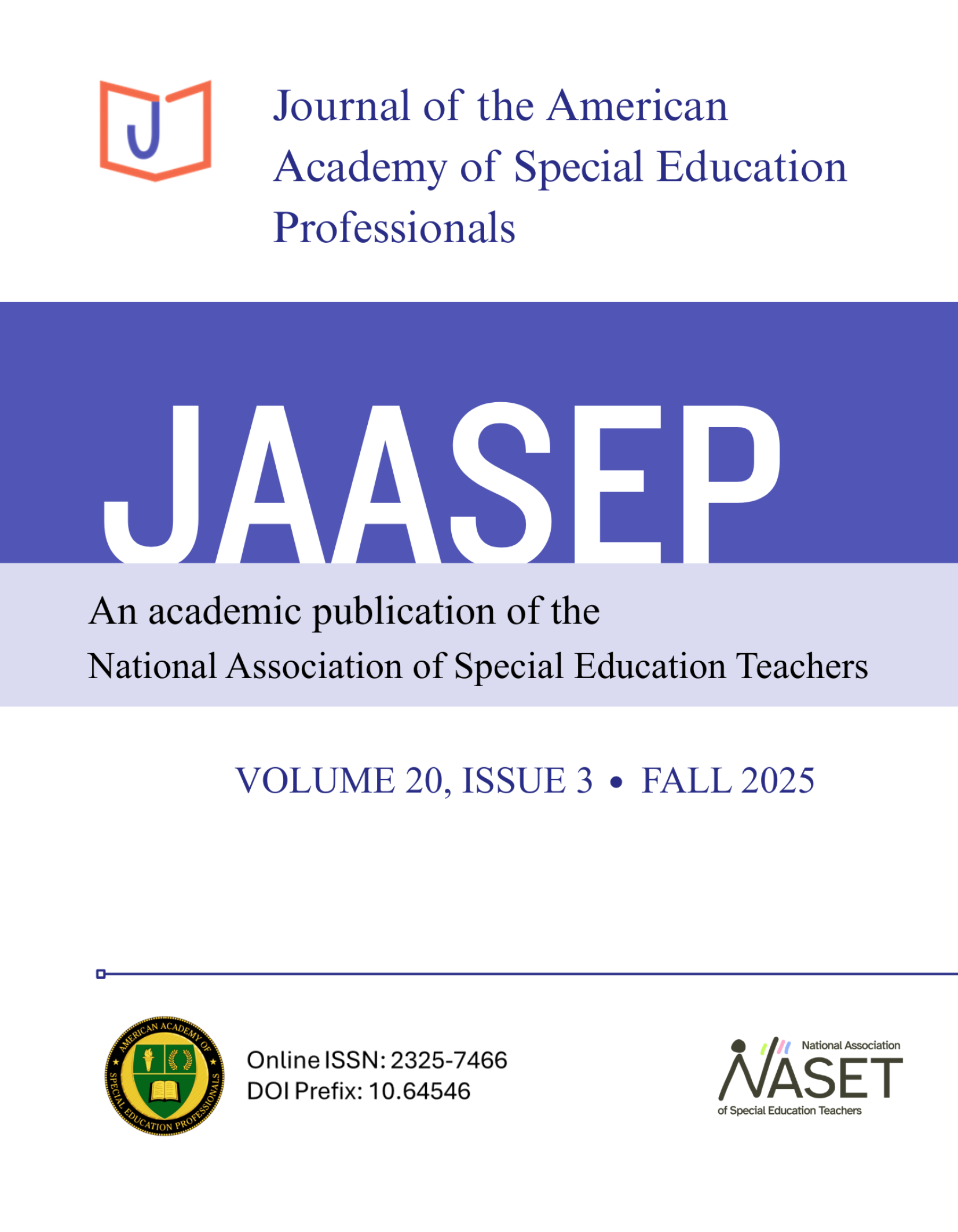Special education and trauma: Are we correctly identifying our students?
Brunzell, T., Stokes, H., & Waters, L. (2018). Why do you work with struggling students? Teacher perceptions of meaningful work in trauma-impacted classrooms. Australian Journal of Teacher Education, 43(2), 116–142. https://doi.org/10.14221/ajte.2018v43n2.7 DOI: https://doi.org/10.14221/ajte.2018v43n2.7
Brunzell, T., Waters, L., & Stokes, H. (2015). Teaching with strengths in trauma-affected students: A new approach to healing and growth in the classroom. American Journal of Orthopsychiatry, 85(1), 3–9. https://doi.org/10.1037/ort0000048 DOI: https://doi.org/10.1037/ort0000048
Centers for Disease Control and Prevention. (2023, June 29). Fast facts: Preventing adverse childhood experiences |violence prevention|injury Center|CDC. Centers for Disease Control and Prevention. https://www.cdc.gov/violenceprevention/aces/fastfact.html#prin
Chudzik, M., Corr, C., & Fisher, K. W. (2023). Trauma-informed care: The professional development needs of Early Childhood Special Education Teachers. Journal of Early Intervention, 46(1), 113–129. https://doi.org/10.1177/10538151231164898 DOI: https://doi.org/10.1177/10538151231164898
Decker, D. M., Wolfe, J. L., & Belcher, C. K. (2021). A 30-year systematic review of Professional Ethics and teacher preparation. The Journal of Special Education, 55(4), 201–212. https://doi.org/10.1177/0022466921989303 DOI: https://doi.org/10.1177/0022466921989303
Ermis-Demirtas, H., Luo, Y., & Huang, Y.-J. (2022). The trauma of covid-19–fueled discrimination: Posttraumatic stress in Asian American adolescents. Professional School Counseling, 26(1b). https://doi.org/10.1177/2156759x221106814 DOI: https://doi.org/10.1177/2156759X221106814
Hackney, A. J., Graham, N. R., Jolivette, K., & Sanders, S. (2023). Creating Trauma-Informed Spaced for Youth in Residential Programs. Journal of the American Academy of Special Education Professionals, 32–45. DOI: https://doi.org/10.64546/jaasep.509
Hoogstad, A., Mevissen, L., & Didden, R. (2023). Posttraumatic stress disorder in children with severe or moderate intellectual disability: A study using the diagnostic interview trauma, stressors – severe/moderate ID. Journal of Developmental and Physical Disabilities. https://doi.org/10.1007/s10882-023-09928-2 DOI: https://doi.org/10.1007/s10882-023-09928-2
Hudspeth, E. F. (2015). Children with special needs and circumstances: Conceptualization through a complex trauma lens. The Professional Counselor, 5(2), 195–199. https://doi.org/10.15241/efh.5.2.195 DOI: https://doi.org/10.15241/efh.5.2.195
Johnson, K. F., Ieva, K., & Byrd, J. (2022). Introduction to the special issue on school counselors addressing education, health, wellness, and trauma disparities. Professional School Counseling, 26(1b). https://doi.org/10.1177/2156759x221105451 DOI: https://doi.org/10.1177/2156759X221105451
Jolivette, K., Sanders, S., Michael, E., & Hackney, A. J. (2023). This prompt or that prompt: Applying a trauma-informed lens to writing instruction for students with and at risk for EBD. Beyond Behavior. https://doi.org/10.1177/10742956231219947 DOI: https://doi.org/10.1177/10742956231219947
Jones, L., Bellis, M. A., Wood, S., Hughes, K., McCoy, E., Eckley, L., Bates, G., Mikton, C., Shakespeare, T., & Officer, A. (2012). Prevalence and risk of violence against children with disabilities: A systematic review and meta-analysis of observational studies. The Lancet, 380(9845), 899–907. https://doi.org/10.1016/s0140-6736(12)60692-8 DOI: https://doi.org/10.1016/S0140-6736(12)60692-8
Miller, D., & Santos, R. M. (2019). The characteristics among maltreatment, Special Education Service Delivery, and personnel preparation. The Journal of Special Education, 53(4), 216–225. https://doi.org/10.1177/0022466919836278 DOI: https://doi.org/10.1177/0022466919836278
Miodus, S., Allwood, M. A., & Amoh, N. (2021). Childhood ADHD symptoms in relation to trauma exposure and PTSD symptoms among college students: Attending to and accommodating trauma. Journal of Emotional and Behavioral Disorders, 29(3), 187–196. https://doi.org/10.1177/1063426620982624 DOI: https://doi.org/10.1177/1063426620982624
The National Child Traumatic Stress Network. (2018). https://www.nctsn.org/
Ohio School Report Cards. (2023, December). https://reportcard.education.ohio.gov/district/detail/043711
Ormiston, H. E., Nygaard, M. A., & Apgar, S. (2022). A systematic review of secondary traumatic stress and compassion fatigue in teachers. School Mental Health, 14(4), 802–817. https://doi.org/10.1007/s12310-022-09525-2 DOI: https://doi.org/10.1007/s12310-022-09525-2
O’Neill, L., Guenette, F., & Kitchenham, A. (2010). ‘am I safe here and do you like me?’ understanding complex trauma and attachment disruption in the classroom. British Journal of Special Education, 37(4), 190–197. https://doi.org/10.1111/j.1467-8578.2010.00477.x DOI: https://doi.org/10.1111/j.1467-8578.2010.00477.x
Riggs, L., & Landrum, T. (2023). Trauma-informed PBIS: How educators can combine evidence-based practices for behavior management with trauma-informed care. Beyond Behavior, 32(3), 152–161. https://doi.org/10.1177/10742956231201351 DOI: https://doi.org/10.1177/10742956231201351
Screening tools. ACEs Aware. (2023, December 16). https://www.acesaware.org/learn-about-screening/screening-tools/
Sullivan, P. M., & Knutson, J. F. (2000). Maltreatment and disabilities: A population-based epidemiological study. Child Abuse & Neglect, 24(10), 1257–1273. https://doi.org/10.1016/s0145-2134(00)00190-3 DOI: https://doi.org/10.1016/S0145-2134(00)00190-3
Tuchinda, Nicole. (2020). The imperative for trauma-responsive special education. New York University Law Review, 95(3), 766-836.
Waitoller, F. R., Artiles, A. J., & Cheney, D. A. (2009). The miner’s canary. The Journal of Special Education, 44(1), 29–49. https://doi.org/10.1177/0022466908329226 DOI: https://doi.org/10.1177/0022466908329226
Winder, Felicia. (2015). Childhood trauma and special education: why the idea is failing today's impacted youth. Hofstra Law Review, 44(2), 601-[vi].
Yoon, I. H. (2019). Haunted trauma narratives of inclusion, race, and disability in a school community. Educational Studies, 55(4), 420–435. https://doi.org/10.1080/00131946.2019.1629926 DOI: https://doi.org/10.1080/00131946.2019.1629926
Zetlin, A. (2006). The experiences of Foster Children and youth in special education. Journal of Intellectual & Developmental Disability, 31(3), 161–165. https://doi.org/10.1080/13668250600847039 DOI: https://doi.org/10.1080/13668250600847039
